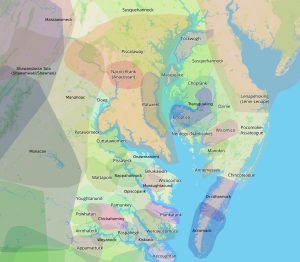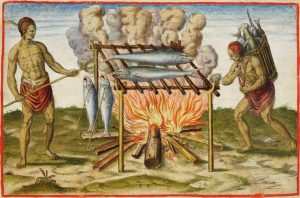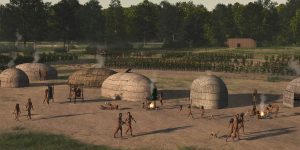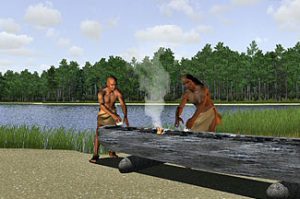As we sail the waters of the Chesapeake Bay, we’re traveling through what was once one of the most populous and sophisticated Native American regions in North America, and had been so for thousands of years. When Captain John Smith first explored these waters in 1608, he encountered numerous tribes belonging to three major groups: the Powhatan Confederacy, the Piscataway (Conoy), and the Nanticoke peoples.

The waters we’re cruising today, around the South River and Annapolis, were primarily the territory of the Piscataway people, who maintained several villages along these shores. Their influence extended from modern-day Baltimore down through the western shore of the Bay.
The area where Baltimore now stands was a crossroads of sorts, where Piscataway territory met that of the Susquehannock people to the north. The Susquehannocks would travel down from their main settlements along the Susquehanna River to fish and trade in the upper Bay. Along the South River itself, archaeological evidence has revealed several significant Native American settlements, including seasonal fishing camps and more permanent villages situated on the high ground overlooking the river’s broad waters.
The eastern shore across from Annapolis was primarily populated by Nanticoke peoples, who were master canoe-builders and watermen. They maintained extensive trade networks across the Bay, often crossing these waters in large canoes to exchange goods with the Piscataway. The area around present-day Annapolis served as an important meeting point for different groups, particularly during the spring fish runs when the waters teemed with shad and herring.
A Rich and Abundant Land

The Chesapeake Bay region was an indigenous peoples’ paradise. Its vast oyster reefs teemed with shellfish, while its waters hosted abundant runs of shad, herring, and sturgeon. Dense forests full of game surrounded the bay, and rich soil provided perfect conditions for agriculture. The numerous navigable waterways created natural highways for travel and trade.The word “Chesapeake” comes from the Algonquian word “Chesepiook,” meaning “great shellfish bay”!
Living with the Seasons
Life in the Chesapeake followed a careful seasonal rhythm. Spring brought fishing during spawning runs and the planting of crops. Summer was spent tending gardens and gathering berries. Fall focused on harvesting crops and hunting, while winter was a time of living off stored food, hunting when possible, and sharing stories around the fire.
Teen History Note: These peoples were expert farmers who developed sophisticated methods of sustainable agriculture that we still study today!
Homes and Villages

Villages were typically located near water, but on higher ground to avoid flooding. The people constructed longhouses or roundhouses covered with bark or reed mats, arranging them around a central plaza. Some villages were fortified with wooden palisades for protection. Special buildings housed food storage and community gatherings. Following a careful pattern of sustainable land use, most villages moved every few decades as soil and resources were depleted.
Agriculture, Hunting and Fishing
At the heart of their agricultural practice were corn (maize), beans, and squash. These crops were planted together in a sophisticated companion planting system. The corn provided poles for beans to climb, while the beans fixed nitrogen in the soil. Squash leaves spread across the ground, preventing weeds and retaining moisture.
These peoples were master hunters and fishers who developed sophisticated techniques over generations. Hunters used bows and arrows with stone points, spears and atlatls (spear-throwers), along with various snares and traps. They often conducted communal deer drives to harvest game efficiently.
 Their fishing methods were equally advanced. They constructed fish weirs – stone or wooden underwater fences that guided fish into traps. They crafted nets from plant fibers, fashioned spears and harpoons for larger fish, and carved hooks from bone. They also created ingenious basket traps for catching fish.
Their fishing methods were equally advanced. They constructed fish weirs – stone or wooden underwater fences that guided fish into traps. They crafted nets from plant fibers, fashioned spears and harpoons for larger fish, and carved hooks from bone. They also created ingenious basket traps for catching fish.
Transportation, Trade and Sustainable Living
The waterways of the Chesapeake were highways of trade and sustenance, navigated by impressive dugout canoes that were engineering marvels of their time. These vessels, some reaching lengths of 40 to 50 feet, were crafted through a painstaking process that could take months to complete. Using controlled fire and stone tools, craftsmen would carefully hollow out massive tulip poplar or pine logs. A single large canoe could carry several thousand pounds of cargo or up to 40 people, making possible extensive trade networks throughout the Bay.
These canoes were essential for harvesting the Bay’s abundant resources, particularly oysters and rockfish (striped bass). The indigenous peoples developed sophisticated methods for harvesting oysters in various depths, using long-handled tongs in shallow waters and weighted lines in deeper areas. They understood the importance of oyster reefs as habitat and would selectively harvest to maintain reef structure. The massive oyster reefs of their time were so large they posed navigation hazards, breaking the surface at low tide and forcing canoes to follow specific channels through the Bay.

Rockfish held special significance as well. These magnificent fish were harvested during their seasonal runs, particularly in spring when they moved up rivers to spawn. Fish weirs and nets were positioned at strategic points along rivers like the South River to intercept these runs. The people understood the rockfish’s migration patterns so well that they could predict their arrival and plan seasonal gatherings around these events.
Trade flowed throughout the region, bringing copper from the Great Lakes, shells from the coast, stone tools from mountain quarries, along with preserved foods, furs, medicines, and ceremonial items. Perhaps most importantly, these peoples developed sophisticated systems for sustainable resource use. They rotated fishing grounds to prevent overharvesting, moved villages to allow soil recovery, used controlled burning to manage forest resources, and carefully timed their harvests to ensure resource renewal.
So, bear in mind that the waters and land of the Chesapeake Bay were not exactly ‘discovered’ by European settlers and colonists – more they became integrated into what was already going on…..
